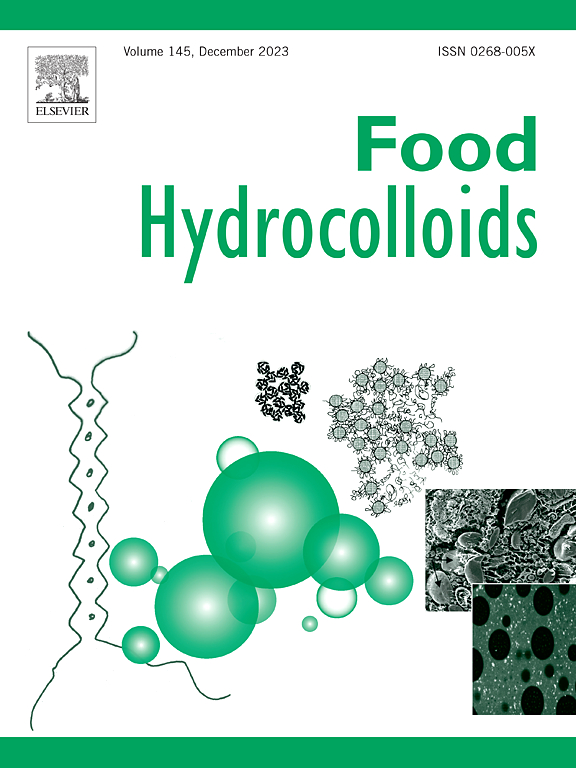Unveiling the impact of superheated steam treatment on nutritional, functional and rheological behavior of guar germ protein isolates
IF 11
1区 农林科学
Q1 CHEMISTRY, APPLIED
引用次数: 0
Abstract
Superheated steam (SHS) treatment offers a rapid and efficient approach for modifying biopolymers, minimizing oxidation and degradation compared to conventional heating methods. Guar germ protein isolates (GGPI), rich in essential amino acids, remain underexplored despite their nutritional potential. However, GGPI faces limitations in solubility, digestibility, and gelling ability. This study investigates the impact of SHS treatment on the nutritional, structural, functional, and rheological properties of GGPI at temperatures of 120, 130, and 140 °C for 5 and 10 min. SHS treatment significantly increased in-vitro protein digestibility up to 130 °C-10 min (89.08 %). However, prolonged exposure to higher temperatures led to a significant reduction in essential amino acids, accompanied by changes in carbonyl and disulfide content. At lower SHS temperatures, no apparent changes in band intensity of SDS-PAGE patterns were found. Also, non-significant differences in surface hydrophobicity and particle size variation suggested that larger aggregates of GGPI were not formed. Partial unfolding of GGPI was observed at lower SHS temperatures, as indicated by higher random coil structure. On the other hand, at higher SHS temperatures, reorganization of unfolded structure into compact structure occurred, as noted by a significant impact on β-sheet structure (37.34–45.12 %). Furthermore, increasing SHS temperature and time significantly improved the solubility (5.99 %) and emulsifying capacity (4.14 %) of GGPI up to 130 °C-10 min. Broader particle size distribution profiles of GGPI after SHS treatment might have accounted for the non-significant variation in water absorption capacity (1.9–2.11 g/g) and foaming capacity. Simultaneously, GGPI treated at 120 °C for 10 min formed a weaker gel with frequency-dependent behavior. Conclusively, SHS treatment could be more effective for preprocessing GGPI or other plant proteins at temperatures ranging from 120 to 130 °C to enhance solubility, digestibility, and gelling ability. Limited oxidation at higher SHS temperature (140 °C) reduced essential amino acids but did not form larger aggregates, making it suitable for producing low viscous food items.

求助全文
约1分钟内获得全文
求助全文
来源期刊

Food Hydrocolloids
工程技术-食品科技
CiteScore
19.90
自引率
14.00%
发文量
871
审稿时长
37 days
期刊介绍:
Food Hydrocolloids publishes original and innovative research focused on the characterization, functional properties, and applications of hydrocolloid materials used in food products. These hydrocolloids, defined as polysaccharides and proteins of commercial importance, are added to control aspects such as texture, stability, rheology, and sensory properties. The research's primary emphasis should be on the hydrocolloids themselves, with thorough descriptions of their source, nature, and physicochemical characteristics. Manuscripts are expected to clearly outline specific aims and objectives, include a fundamental discussion of research findings at the molecular level, and address the significance of the results. Studies on hydrocolloids in complex formulations should concentrate on their overall properties and mechanisms of action, while simple formulation development studies may not be considered for publication.
The main areas of interest are:
-Chemical and physicochemical characterisation
Thermal properties including glass transitions and conformational changes-
Rheological properties including viscosity, viscoelastic properties and gelation behaviour-
The influence on organoleptic properties-
Interfacial properties including stabilisation of dispersions, emulsions and foams-
Film forming properties with application to edible films and active packaging-
Encapsulation and controlled release of active compounds-
The influence on health including their role as dietary fibre-
Manipulation of hydrocolloid structure and functionality through chemical, biochemical and physical processes-
New hydrocolloids and hydrocolloid sources of commercial potential.
The Journal also publishes Review articles that provide an overview of the latest developments in topics of specific interest to researchers in this field of activity.
 求助内容:
求助内容: 应助结果提醒方式:
应助结果提醒方式:


